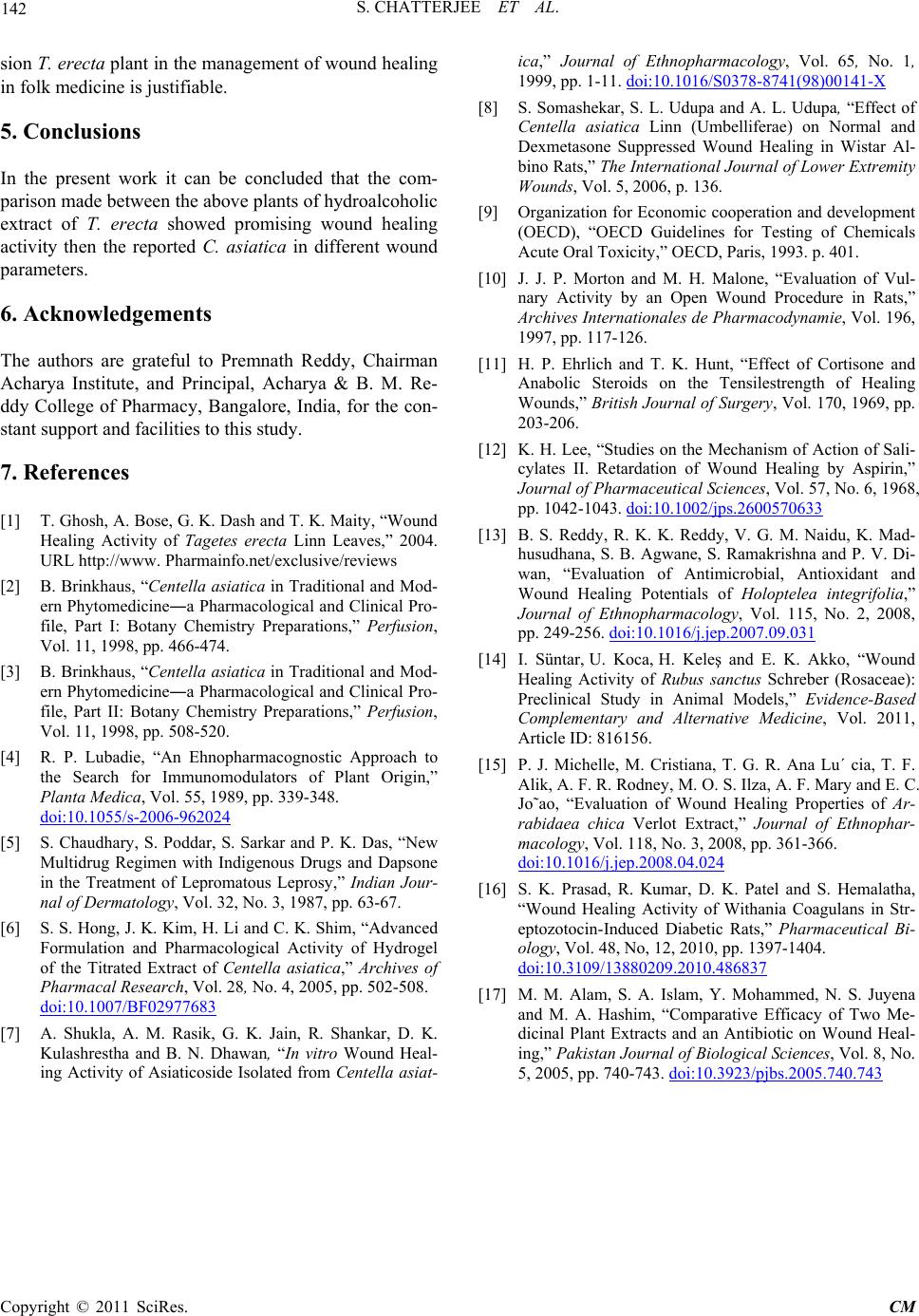
S. CHATTERJEE ET AL.
142
sion T. erecta plant in the management of wound healing
in folk medicine is justifiable.
5. Conclusions
In the present work it can be concluded that the com-
parison made between the above plants of hydroalcoholic
extract of T. erecta showed promising wound healing
activity then the reported C. asiatica in different wound
parameters.
6. Acknowledgements
The authors are grateful to Premnath Reddy, Chairman
Acharya Institute, and Principal, Acharya & B. M. Re-
ddy College of Pharmacy, Bangalore, India, for the con-
stant support and facilities to this study.
7. References
[1] T. Ghosh, A. Bose, G. K. Dash and T. K. Maity, “Wound
Healing Activity of Tagetes erecta Linn Leaves,” 2004.
URL http://www. Pharmainfo.net/exclusive/reviews
[2] B. Brinkhaus, “Centella asiatica in Traditional and Mod-
ern Phytomedicine―a Pharmacological and Clinical Pro-
file, Part I: Botany Chemistry Preparations,” Perfusion,
Vol. 11, 1998, pp. 466-474.
[3] B. Brinkhaus, “Centella asiatica in Traditional and Mod-
ern Phytomedicine―a Pharmacological and Clinical Pro-
file, Part II: Botany Chemistry Preparations,” Perfusion,
Vol. 11, 1998, pp. 508-520.
[4] R. P. Lubadie, “An Ehnopharmacognostic Approach to
the Search for Immunomodulators of Plant Origin,”
Planta Medica, Vol. 55, 1989, pp. 339-348.
doi:10.1055/s-2006-962024
[5] S. Chaudhary, S. Poddar, S. Sarkar and P. K. Das, “New
Multidrug Regimen with Indigenous Drugs and Dapsone
in the Treatment of Lepromatous Leprosy,” Indian Jour-
nal of Dermatology, Vol. 32, No. 3, 1987, pp. 63-67.
[6] S. S. Hong, J. K. Kim, H. Li and C. K. Shim, “Advanced
Formulation and Pharmacological Activity of Hydrogel
of the Titrated Extract of Centella asiatica,” Archives of
Pharmacal Research, Vol. 28, No. 4, 2005, pp. 502-508.
doi:10.1007/BF02977683
[7] A. Shukla, A. M. Rasik, G. K. Jain, R. Shankar, D. K.
Kulashrestha and B. N. Dhawan, “In vitro Wound Heal-
ing Activity of Asiaticoside Isolated from Centella asiat-
ica,” Journal of Ethnopharmacology, Vol. 65, No. 1,
1999, pp. 1-11. doi:10.1016/S0378-8741(98)00141-X
[8] S. Somashekar, S. L. Udupa and A. L. Udupa, “Effect of
Centella asiatica Linn (Umbelliferae) on Normal and
Dexmetasone Suppressed Wound Healing in Wistar Al-
bino Rats,” The International Journal of Lower Extremity
Wounds, Vol. 5, 2006, p. 136.
[9] Organization for Economic cooperation and development
(OECD), “OECD Guidelines for Testing of Chemicals
Acute Oral Toxicity,” OECD, Paris, 1993. p. 401.
[10] J. J. P. Morton and M. H. Malone, “Evaluation of Vul-
nary Activity by an Open Wound Procedure in Rats,”
Archives Internationales de Pharmacodynamie, Vol. 196,
1997, pp. 117-126.
[11] H. P. Ehrlich and T. K. Hunt, “Effect of Cortisone and
Anabolic Steroids on the Tensilestrength of Healing
Wounds,” British Journal of Surgery, Vol. 170, 1969, pp.
203-206.
[12] K. H. Lee, “Studies on the Mechanism of Action of Sali-
cylates II. Retardation of Wound Healing by Aspirin,”
Journal of Pharmaceutical Sciences, Vol. 57, No. 6, 1968,
pp. 1042-1043. doi:10.1002/jps.2600570633
[13] B. S. Reddy, R. K. K. Reddy, V. G. M. Naidu, K. Mad-
husudhana, S. B. Agwane, S. Ramakrishna and P. V. Di-
wan, “Evaluation of Antimicrobial, Antioxidant and
Wound Healing Potentials of Holoptelea integrifolia,”
Journal of Ethnopharmacology, Vol. 115, No. 2, 2008,
pp. 249-256. doi:10.1016/j.jep.2007.09.031
[14] I. Süntar, U. Koca, H. Keleş and E. K. Akko, “Wound
Healing Activity of Rubus sanctus Schreber (Rosaceae):
Preclinical Study in Animal Models,” Evidence-Based
Complementary and Alternative Medicine, Vol. 2011,
Article ID: 816156.
[15] P. J. Michelle, M. Cristiana, T. G. R. Ana Lu´ cia, T. F.
Alik, A. F. R. Rodney, M. O. S. Ilza, A. F. Mary and E. C.
Jo˜ao, “Evaluation of Wound Healing Properties of Ar-
rabidaea chica Verlot Extract,” Journal of Ethnophar-
macology, Vol. 118, No. 3, 2008, pp. 361-366.
doi:10.1016/j.jep.2008.04.024
[16] S. K. Prasad, R. Kumar, D. K. Patel and S. Hemalatha,
“Wound Healing Activity of Withania Coagulans in Str-
eptozotocin-Induced Diabetic Rats,” Pharmaceutical Bi-
ology, Vol. 48, No, 12, 2010, pp. 1397-1404.
doi:10.3109/13880209.2010.486837
[17] M. M. Alam, S. A. Islam, Y. Mohammed, N. S. Juyena
and M. A. Hashim, “Comparative Efficacy of Two Me-
dicinal Plant Extracts and an Antibiotic on Wound Heal-
ing,” Pakistan Journal of Biological Sciences, Vol. 8, No.
5, 2005, pp. 740-743. doi:10.3923/pjbs.2005.740.743
Copyright © 2011 SciRes. CM